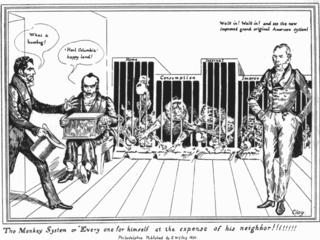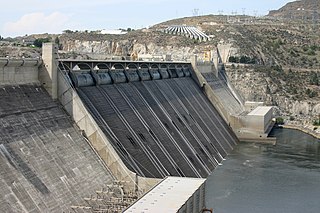 W
WThe American System was an economic plan that played an important role in American policy during the first half of the 19th century. Rooted in the "American School" ideas of Alexander Hamilton, the plan "consisted of three mutually reinforcing parts: a tariff to protect and promote American industry; a national bank to foster commerce; and federal subsidies for roads, canals, and other 'internal improvements' to develop profitable markets for agriculture". Congressman Henry Clay was the plan's foremost proponent and the first to refer to it as the "American System".
 W
WThe Assistant Secretary of State for Economic and Business Affairs is an office in the United States Department of State responsible for managing the Bureau of Economic and Business Affairs. It was known as the Assistant Secretary of State for Economic Affairs from December 1944 to September 15, 1972.
 W
WThe Bureau of Economic and Business Affairs (EB) is a bureau of the U.S. Department of State charged with promoting economic security and prosperity at home and abroad. It reports to the Under Secretary of State for Economic Growth, Energy, and the Environment. The Bureau's work lies at the nexus of economic prosperity and national security. In addition, EB also addresses a range of economic issues including intellectual property rights, piracy, and counterfeiting. As the single point where international economic policy tools and threads converge, EB helps to promote a coherent economic policy across the U.S. government. Since January 20, 2021 it is headed by the Principal Deputy Assistant Secretary, Peter Haas, as Acting Assistant Secretary of State for Economic and Business Affairs.
 W
WThe Council of Economic Advisers (CEA) is a United States agency within the Executive Office of the President established in 1946, which advises the President of the United States on economic policy. The CEA provides much of the empirical research for the White House and prepares the publicly-available annual Economic Report of the President.
 W
WThe U.S. Economic Development Administration (EDA) is an agency in the United States Department of Commerce that provides grants and technical assistance to economically distressed communities in order to generate new employment, help retain existing jobs and stimulate industrial and commercial growth through a variety of investment programs.
 W
WThe Under Secretary for Economic Growth, Energy, and the Environment is an undersecretary position within the United States Department of State. The Under Secretary for Economic Growth, Energy, and the Environment serves as senior economic advisor at the State Department and advises the Secretary of State on international economic policy and is often referred to as the senior economic diplomat of the United States. The Under Secretary also leads the work of the Department on trade, agriculture, aviation, and bilateral trade relations with America's economic partners.
 W
WThe "Fed model" or "Fed Stock Valuation Model" (FSVM), is a disputed theory of equity valuation that compares the stock market's forward earnings yield to the nominal yield on long-term government bonds, and that the stock market – as a whole – is fairly valued, when the one-year forward-looking I/B/E/S earnings yield equals the 10-year nominal Treasury yield; deviations suggest over-or-under valuation.
 W
WThe Global Investment in American Jobs Act of 2013 is a bill that would require the United States Department of Commerce, in cooperation with the Federal Interagency Investment Working Group and other federal agencies, to "conduct a review of the global competitiveness of the United States in attracting foreign direct investment." The bill specifies what topics and subject matters are to be included in the report, and which laws or policies are not to be included. Finally, the bill also expressed the "sense of Congress" – non-binding statement of opinion - about the current situation of foreign direct investment in the United States and some related American goals. The bill was introduced into the United States House of Representatives during the 113th United States Congress.
 W
WThe Greenspan put was a monetary policy response to financial crises that Alan Greenspan, former chair of the Federal Reserve, exercised beginning with the crash of 1987. Successful in addressing various crises, it became controversial as it led to periods of extreme speculation led by Wall Street investment banks overusing the put's repurchase agreements and creating successive asset price bubbles. The banks so overused Greenspan's tools that their compromised solvency in the global financial crisis required Fed chair Ben Bernanke to use direct quantitative easing. The term Yellen put was used to refer to the Fed chair Janet Yellen's policy of perpetual monetary looseness.
 W
WThe infrastructure policy of Donald Trump included ensuring U.S. energy independence, safeguarding the cybersecurity of the national power grid and other critical infrastructure, locking China out of the U.S. fifth-generation Internet market, and rolling back regulations to ease the process of planning and construction. While there were no major infrastructure spending packages, some individual policies and projects were advanced piecemeal, especially in rural areas.
 W
WIn late January 2021, the Joe Biden administration stated it would aim for spending on the USA's infrastructure on the order of $2 trillion.
 W
W"Jawboning", or "moral suasion," in economics and politics is the use of authority to persuade various entities to act in certain ways, which is sometimes underpinned by the implicit threat of future government regulation. In the United States, during the Democratic administrations of Presidents John F. Kennedy and Lyndon B. Johnson, officials tried to deal with the mounting inflationary pressures by direct government influence or jawboning. Wage-price guideposts were established, and the power of the presidency pushed businesses and labor into going along with those guideposts. The term attracted some derision and is often associated with the Biblical story in Judges 15:15 of Samson slaying a thousand of his enemies using the jawbone of an ass. Alfred E. Kahn, an economic advisor to Jimmy Carter, was particularly known for his dislike of the method.
 W
WFollowing the global financial crisis of 2007–2008, there was a worldwide resurgence of interest in Keynesian economics among prominent economists and policy makers. This included discussions and implementation of economic policies in accordance with the recommendations made by John Maynard Keynes in response to the Great Depression of the 1930s, most especially fiscal stimulus and expansionary monetary policy.
 W
WMonetary policy concerns the actions of a central bank or other regulatory authorities that determine the size and rate of growth of the money supply. For example, in the United States, the Federal Reserve is in charge of monetary policy, and implements it primarily by performing operations that influence short-term interest rates.
 W
WThe National Economic Council (NEC) of the United States is the principal forum used by the President of the United States for considering economic policy matters, separate from matters relating to domestic policy, which are the domain of the Domestic Policy Council. The council forms part of the Office of White House Policy which contains the National Economic Council and other offices. The Director of the NEC is titled the Assistant to the President for Economic Policy and Director of the National Economic Council. The NEC is distinct from the Council of Economic Advisers (CEA), which was established in 1946. The CEA provides much of the objective empirical research for the White House and prepares the annual Economic Report of the President.
 W
WThe creation of a National Infrastructure Reinvestment Bank was first proposed by United States Senator Christopher J. Dodd and Senator Chuck Hagel in 2007. However, several other iterations of a National Infrastructure Bank have been proposed and considered and it is likely that implementing legislation for the Bank will look quite different from that which was proposed in the original legislation.
 W
WThe New Deal was a series of programs, public work projects, financial reforms, and regulations enacted by President Franklin D. Roosevelt in the United States between 1933 and 1939. Major federal programs and agencies included the Civilian Conservation Corps (CCC), the Civil Works Administration (CWA), the Farm Security Administration (FSA), the National Industrial Recovery Act of 1933 (NIRA) and the Social Security Administration (SSA). They provided support for farmers, the unemployed, youth and the elderly. The New Deal included new constraints and safeguards on the banking industry and efforts to re-inflate the economy after prices had fallen sharply. New Deal programs included both laws passed by Congress as well as presidential executive orders during the first term of the presidency of Franklin D. Roosevelt.
 W
WThe Nixon shock was a series of economic measures undertaken by United States President Richard Nixon in 1971, in response to increasing inflation, the most significant of which were wage and price freezes, surcharges on imports, and the unilateral cancellation of the direct international convertibility of the United States dollar to gold.
 W
WReaganomics, or Reaganism, refers to the neoliberal economic policies promoted by U.S. President Ronald Reagan during the 1980s. These policies are commonly associated with and characterized as supply-side economics, trickle-down economics, or voodoo economics by opponents, while Reagan and his advocates preferred to call it free-market economics.
 W
WSupply-side economics is a macroeconomic theory that postulates economic growth can be most effectively fostered by lowering taxes, decreasing regulation, and allowing free trade. According to supply-side economics, consumers will benefit from greater supplies of goods and services at lower prices, and employment will increase. Demand-side economics is often placed as a contrasting theory.
 W
WThe United States of America has separate federal, state, and local governments with taxes imposed at each of these levels. Taxes are levied on income, payroll, property, sales, capital gains, dividends, imports, estates and gifts, as well as various fees. In 2010, taxes collected by federal, state, and municipal governments amounted to 24.8% of GDP. In the OECD, only Chile and Mexico are taxed less as a share of their GDP.
 W
WThe Trump tariffs are a series of United States tariffs imposed during the presidency of Donald Trump as part of his "America First" economic policy to reduce the United States trade deficit by shifting American trade policy from multilateral free trade agreements to bilateral trade deals. In January 2018, Trump imposed tariffs on solar panels and washing machines of 30 to 50 percent. In March 2018, he imposed tariffs on steel (25%) and aluminum (10%) from most countries, which, according to Morgan Stanley, covered an estimated 4.1 percent of U.S. imports. In June 2018, this was extended to the European Union, Canada, and Mexico. The Trump administration separately set and escalated tariffs on goods imported from China, leading to a trade war.
 W
WThe balance of trade of the United States moved into substantial deficit from the late 1990s, especially with China and other Asian countries. This has been accompanied by a relatively low savings ratio and high levels of government and corporate debt. Debate continues over the causes and impacts of this trade deficit, and the nature of any measures required in response.
 W
WUnstoppable: The Emerging Left–Right Alliance to Dismantle the Corporate State is a non-fiction book by American consumer advocate Ralph Nader, published in 2014 by Nation Books. Nader argues that there are many issues which progressives, libertarians and conservatives can agree on, such as opposition to "free trade" agreements, too much Wall Street influence in Washington, opposition to "corporate welfare", preservation of civil liberties, opposition to foreign military entanglements, etc., and that by working together they can defeat entrenched interest groups and achieve their desired policy outcomes.
 W
WThe Wheat Price Guarantee Act was a 1919 bill passed by Congress that gave the government the power to regulate the price of wheat.
 W
WThe National Trade Council (NTC) of the United States was the principal forum used by the President of the United States to advise on strategies in trade negotiations, coordinate with other agencies to assess U.S. manufacturing capabilities and the defense industrial base, and help match unemployed American workers with new opportunities in the skilled manufacturing sector. The council formed part of the Office of White House Policy which contains the National Economic Council and other offices. President-elect Donald Trump announced his intent to create the office on December 21, 2016, and named Peter Navarro as its inaugural director. In April 2017, the NTC was folded into the newly created Office of Trade and Manufacturing Policy; by September 2017, both the NTC and OTMP were reorganized again and placed under the National Economic Council by then White House Chief of Staff John Kelly. In February 2018 the OTMP regained independence. Although the National Trade Council was said to have still existed later into the Trump administration, its responsibilities and duties had largely been taken over by the Office of Trade and Manufacturing policy, rendering the Council effectively defunct.
 W
WWho Stole the American Dream? is a non-fiction book by the American author and journalist Hedrick Smith published in 2012 by Random House.